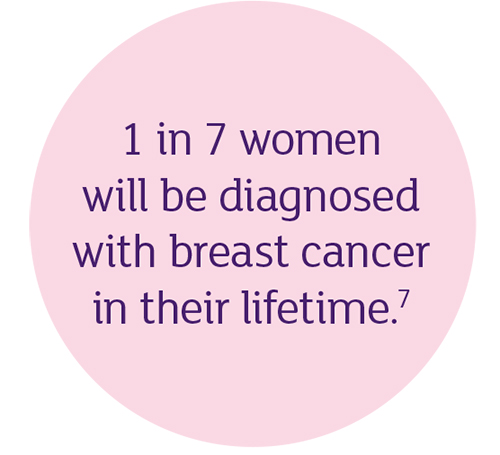Social Media Campaign
Campaign overview
Cancer Institute NSW is delivering the 2022/23 BreastScreen NSW Always On Social Media Campaign to motivate women aged 50–74 in NSW to have a breast screen every two years.
The campaign is live from 1 July 2022 to 30 June 2023 and is being delivered across Facebook and Instagram.
Why we need a campaign
Breast cancer is the most common cancer affecting women in NSW. In 2017 alone, breast cancer claimed the lives of 928 women in NSW.1
Despite this, almost 650,000 NSW women in the target age group haven’t had their recommended breast screen in the past two years.2 This means that more than 50% of eligible women are not screening regularly with BreastScreen NSW.3 NSW has the third lowest national breast screening participation rate.4

Having a regular breast screen saves lives by finding breast cancers early, before they can be seen or felt. It is estimated an additional 2,700 invasive breast cancers would be detected if each eligible woman was to have a mammogram every two years5.
By increasing the number of women who complete their breast screens, more breast cancers can be detected early, with more treatment options and lives saved6.
Target audience
The campaign will target women aged 50–74 in NSW, including a specific focus on Aboriginal women and Mandarin and Cantonese speakers.
Key messages
- Breast cancer is the most common cancer affecting women in NSW.
- 9 in 10 women who develop breast cancer do not have a family history of the disease.
- You can have breast cancer without any symptoms.
- Breast screening is recommended for women aged 50–74 every two years – most breast cancers occur in this age group.
- Breast screening is free, and an appointment only takes 20 minutes.
- To book your free breast screen, visit book.breastscreen.nsw.gov.au or call 13 20 50.
Campaign assets
The 2022/23 BreastScreen NSW social media campaign uses factual, engaging ads to educate women about breast cancer screening. The ads aim to raise awareness among the target audience about the importance of screening, encourage community support and engagement, and motivate women to book their next breast screen.
See below some examples of the asset types used in the campaign or visit our Facebook page.
Download 2022/23 BreastScreen NSW Always On Social Media Campaign Toolkit flyer (.pdf)
Further information
- For further information about the campaign and our work to improve survival rates of women by detecting breast cancer early, visit https://www.breastscreen.nsw.gov.au
- Or contact us directly at: cinsw-breastscreennsw@health.nsw.gov.au
Further information
For further information about the campaign and our work to improve survival rates of women by detecting breast cancer early, visit https://www.breastscreen.nsw.gov.au.
Or contact us directly at: cinsw-breastscreennsw@health.nsw.gov.au.
- NSW Cancer Registry Number of deaths by cancer figures 2013–2017 – https://www.cancer.nsw.gov.au/research-and-data/cancer-data-and-statistics/cancer-statistics-nsw#//
- Cancer Institute NSW analysis as January 2022 based on participation rates as at Dec 21 and invasive cancer detection rates for women aged 50–74 in 2020.
- Cancer Institute NSW. Business Information Systems. May 2022.
- BreastScreen Australia Monitoring Report 2021 page 70, Australian Institute of Health and Welfare. https://www.aihw.gov.au/getmedia/e414a344-ab3d-4a35-a79b-a29723f22939/aihwcan-135.pdf.aspx?inline=true
- Cancer Institute NSW. Business Information Systems. May 2022.
- National Breast and Ovarian Cancer Centre (NBOCC) 2009. National Breast and Ovarian Cancer Centre and Royal Australasian College of Surgeons National Breast Cancer audit. Public Health Monitoring Series 2007 data, page 5. Sydney: NBOCC. https://www.canceraustralia.gov.au/publications-and-resources/cancer-australia-publications/nbocc-and-racs-national-breast-cancer-audit-public-health-monitoring-series-2007-data
- Australian Institute of Health and Welfare 2021. BreastScreen Australia Monitoring Report 2021. https://www.aihw.gov.au/reports/cancer-screening/breastscreen-australia-monitoringreport-2021/summary. Cancer series no. 129. Cat. no. CAN 135. Canberra: AIHW. page 2 www.cancer.nsw.gov.au/research-and-data/cancer-data-and-statistics/cancer-statistics-nsw#//analysis/incidence/
- The Lancet 2001. Familial breast cancer: collaborative reanalysis of individual data from 52 epidemiological studies including 58,209 women with breast cancer and 101,986 women without the disease. [online] 358(9291), pp.1389–1399. https://www.thelancet.com/journals/lancet/article/PIIS0140-6736(01)06524-2/fulltext
- Australian Institute of Health and Welfare 2021. BreastScreen Australia Monitoring Report 2021. Cat. no. CAN 140. Canberra: AIHW. page 3 https://www.aihw.gov.au/getmedia/3e239e9c-31ec-4978-bddc-baaf109cc690/aihw-can-140.pdf.aspx?inline=true

